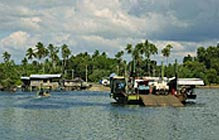
Sunday, January 6, 2008
Subscribe to:
Post Comments (Atom)
Traveler's Choice!
The"wild man of Borneo"

The Sepilok Orangutan Rehabilitation Centre was established in 1964 to return orphaned "apes back to the wild. The centre was being administered by the wildlife section of the Forestry Department which in 1988 was upgraded as a department under the Ministry of Tourism and Environmental Development. All administration and management was given to the new Wildlife Department of Sabah. The objectives of the project have expanded in recent years. While Orangutan rehabilitation is stilt the primary goal at Sepilok, present aims include public education on conservation, research and assistance to other endangered species such as captive breeding of the rare and endangered rhinoceros. This centre is now under the supervision of more than 37 staff, including a Wildlife Officer who is also officer-in-charge of the centre, a veterinary doctor, wildlife rangers and general workers. The centre has a reception centre, information centre, offices for wildlife staff, an animal clinic, quarantine area and enclosures for various animals such as the rhinoceros. Sepilok, renowned for its orangutan rehabilitation project, has stimulated a greater local and international awareness of the protection laws for endangered species, and the Centre has resulted in an increase in detection and confiscation of illegally held captive animals.
Kinabatang River Cruise

Kinabatangan River’ is Sabah’s longest river and measures 560 km from its headwaters in the southwest of the state and empties into the Sulu Sea, east of Sandakan. This area is known to have the most conservation of wildlife in the whole Island of Borneo whom is the third largest Island in the world. Sightings of the unique Proboscis Monkeys are common among the rainforest in the late afternoon. One may also catch a glimpse of a wild Orang Utan, leaf monkeys, gibbons, macaques or the newly discovered “Borneon Pgymy Elephants”. Though elephants and larger animals come and go-herd often break up to get through to plantations encroaching many areas. Bird lovers will find the bird-watching incredible: all 8 of Borneo’s hornbill species are seen regularly. Occasionally, two species of the gorgeous pitas can be spotted, as well as the Storm’s stork and the bizarre Oriental darter or ‘Snake Bird’ in any short trek can be sight. The lodge is located out of the normal tourist route and has been built by using a recycle wood and placed out of the tourist route in order to enjoy the surrounding nature and to minimize the impact.





No comments:
Post a Comment